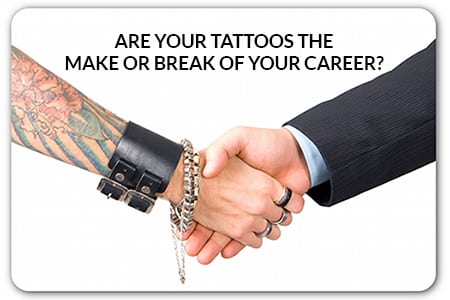
Apr 13, 2016
Discrimination is an issue which is still rife throughout everyday life across the globe. Originating from the UK, I have seen various forms of discrimination in my various roles, ranging from discrimination on the grounds of sex and race through to judgements made on stereotypes and physical appearance. I found this topic fascinating how some areas of a person’s beliefs and gender are legally protected under the current UK legislation in the form of the Equality Act 2010. However, other decisions one can make on their physical appearances, such as hairstyle, piercings and tattoos are not legally protected allowing employers to refuse to hire or terminate depending on what could be argued as their lifestyle choices.
Why Tattoos?
After succumbing to my rebellious side, I am the proud (or not so proud) owner of two tattoos. My previous work required me always to wear black tights so that no one could see the cute rose on my foot. Secondly, while doing masters at the age of 25, on a whim I went and got my nose pierced. When going into my first HR job interview, I removed this piercing as an automatic response to how I felt I could be judged and didn’t want to risk leaving what I thought would be a negative impression. Why I thought/assumed this might be the subconscious scarring from my previous work where tattoos and piercing were something only the devil would partake in.
These factors and experiences are what stemmed the interest for my Master’s dissertation. Do employees believe issues of discrimination relating to protected characteristics still occur today? This could be in the form of age, sex, race or disability. I also wanted to consider features such as physical appearance which are NOT classed as a protected characteristic and whether active discriminatory employment decisions are being made by an individual’s looks. Choice in physical appearance is not considered as a protected characteristic, and therefore employers have the discretion and prerogative to make employment decisions based on an individual’s tattoos, piercings or choice in hairstyle.
Discrimination in work: Protected characteristics
According to the Equality Act 2010, section 4, in the UK, the following features are considered protected characteristics when relating to a working environment:
- Age
- Disability
- Gender reassignment
- Marriage and civil partnership
- Race
- Religion or belief
- Sex
- Sexual orientation
It is essential employers have a detailed understanding of these protected characteristics to avoid forms of direct, indirect or discrimination by association. The 2013 Allen and Overy LLP report states that 15.3% of all employment claims accounted for were discrimination claims relating to one or more of the above-protected characteristics. It is clear that there is not always a deep understanding or structure in place within an organisation to avoid conflict and unfavourable treatment.
For an organisation to minimise the potential for discrimination and adverse treatment, Allen and Overy highlight that ‘the starting point is to understand the level of employee knowledge’. Detailed and precise training for all staff is essential to avoid potential claims of discrimination relating to any of the mentioned protected characteristics. Organisational strategies must be formed surrounding discrimination to create a high level of protection for all employees and employers with regards to potential lawsuits.
Discrimination in work: Non-protected characteristics
Moving on to non-protected characteristics, the main aim of my research was to understand whether physical and personal choices that are made regarding an individual’s appearance, result in forms of discrimination or unfavourable treatment by employers. I found in previous companies I worked for I was required to take out various piercings and wear thick black tights to cover a small foot tattoo. While this is not illegal in the eyes of UK employment law, it can still be viewed as company control and push for regimented autonomy.
I wanted to investigate further whether employees experienced any challenges or issues resulting from their appearance rather than their working ability. When discussing the physical appearance of an employee, I was focused on what could be considered as a ‘lifestyle choice’, such as tattoos, body piercings and varied hairstyles. Individuals may take into account these as important aspects of their personality and identity. Theorist Ramachandran argues that ‘without the freedom of dress… we do not have freedom over our self-determination’. In a company dictating how each employee should look from a physical standpoint, employees may be resentful and discouraged to become part of the team. Individuals may feel that in expressing themselves through tattoos, piercings or in other ways, they are taking control of their physical self and therefore creating their identity.
Should physical appearance be covered by the EA2010?
I was interested to find out if employees with unprotected characteristics such as tattoos, piercings and extreme hair styles believe the United Kingdom should be looking to introduced legislation which covers individuals under the Equality Act 2010. Unlike France, Spain, Argentina, and the USA, currently in the UK, physical appearance does not fall under any form of protected characteristic therefore claims of discrimination for unfavourable or unfair treatment would not stand up in a court of law. Adamitis highlights that ‘protection from appearance discrimination is extremely limited’ which allows employers to create pre-conceived notions or stereotypes regarding an individual’s appearance even though it may have no relation to their ability to perform. If employees had been subjected to what they would consider as unfavourable treatment, was it due to their choice of personal appearance, and if so were opportunities such as a promotion or salary increases missed? As legislation does not protect this sector of employees, employers reserve the right to make potentially unjustified judgments and only not hire an individual based on their looks.
Do employees stand a chance?
It has been argued that when looking at an individual complaint relating to appearance discrimination, it may not be taken in a serious manner. However, if a significant portion of employees has been subjected to this form of unfavourable treatment, its importance is heightened. Academic Rhode, argues that this type of discrimination imposes the same psychological and social detriments that legal forms of discrimination pose such as the compromise of ‘personal dignity and social equality’. With the absence of legal intervention, forms of self -expression may be limited within an organisation. Rhode states that between 12% and 16 % of American workers have felt discriminated against due to their personal choices of self-expression. Taking this into account, 33% believe that employees who may be considered as ‘unconventional’ should be protected legally similarly to an individual with a disability.
Country to country
Since moving to Australia, I have felt there is a lot less pressure to conform and cover up so to speak in the workplace. Now, that could be argued to the more relaxed culture in comparison to the UK. However, this is just one Brit’s perspective! After some research in Australian journals, I found that according to the Australasian Journal of Dermatology, ‘significant bias exists against the employment of persons with visible tattoos in the hospitality, beauty, retail and office sectors where less than 30% of those surveyed would employ a person with a tattoo. All industries except building and the public service admitted that they would be influenced by a visible tattoo in over 40% of cases’.
It can be argued that if employees are being discriminated against due to their personal choices in appearance, should they be conforming to the company’s ideals and if not, should there be increased legislation passed to further protect employees?
Personally, I am content with my rather discreet tattoos as in general they can be covered if I feel appropriate. However, would I have preconceptions or form judgements based on stereotypes when interviewing a candidate with flesh holes and covered in tattoos? Would you?




